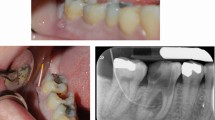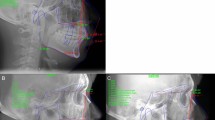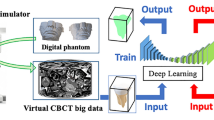Key Points
-
CBCT is a relatively new technology to dentistry, used for the 3D imaging of the teeth and jaws.
-
Radiation dose to the patient is much less than for conventional CT scanners, but still higher than for conventional 2D dental imaging.
-
Training is crucial for all members of the dental team involved in CBCT radiography and radiology.
Abstract
Cone Beam Computed Tomography is a relatively new three-dimensional imaging technology, which has been specifically developed for imaging of the teeth and jaws. The aim of this paper is to acquaint the dental team with various forms of this technology and its potential applications. An understanding of the underlying principles will allow the users of this technology to tailor the imaging protocol to the patient's individual needs to achieve appropriate imaging at the lowest radiation dose.
Similar content being viewed by others
Log in or create a free account to read this content
Gain free access to this article, as well as selected content from this journal and more on nature.com
or
References
Whaites E. Periapical radiography. In: Essentials of dental radiology and radiography, 4th ed. Chapter 10. Churchill Livingston Elsevier, 2007.
Cohenca N, Simon J H, Roges R, Morag Y, Malfaz J M . Clinical indications for digital imaging in dento-alveolar trauma. Part 1: traumatic injuries. Dent Traumatol 2007; 23: 95–104.
Patel S, Dawood A, Whaites E, Pitt Ford T . New dimensions in endodontic imaging: part 1. Conventional and alternative radiographic systems. Int Endod J 2009; 42: 447–462.
Gröndahl H-G, Huumonen S. Radiographic manifestations of periapical inflammatory lesions. Endod Top 2004; 8: 55–67.
Revesz G, Kundel H L, Graber M A . The influence of structured noise on the detection of radiologic abnormalities. Invest Radiol 1974; 6: 479–486.
Kundel H L, Revesz G . Lesion conspicuity, structured noise, and film reader error. AJR Am J Roentgenol 1976; 126: 1233–1238.
White S, Pharaoh M . Advanced imaging modalities. Oral radiology: principles and interpretation, 5th ed. Chapter 13. St Louis, Mo: Mosby, 2004.
Hounsfield G N. Computerised transverse axial scanning (tomography): Part 1. Description of system. Br J Radiol 1973; 46: 1016–1022.
Arai Y, Tammisalo E, Iwai K, Hashimoto K, Shinoda K . Development of a compact computed tomographic apparatus for dental use. Dentomaxillofac Radiol 1999; 28: 245–248.
Mozzo P, Procacci C, Tacconi A, Martini P T, Andreis I A . A new volumetric CT machine for dental imaging based on the cone-beam technique: preliminary results. Eur Radiol 1999; 8: 1558–1564.
Hashimoto K, Yoshinori Y, Iwai K, Araki M, Kawashima S et al. A comparison of a new limited cone beam computed tomography machine for dental use with a multidetector row helical CT machine. Oral Surg Oral Med Oral Pathol Oral Radiol Endod 2003; 95: 371–377.
Hashimoto K, Kawashima S, Araki M, Sawada K, Akiyama Y . Comparison of image performance between cone-beam computed tomography for dental use and four-row multidetector helical CT. J Oral Sci 2006; 48: 27–34.
Bryant A, Drage N, Richmond S . Study of the scan uniformity from an i-CAT cone beam computed tomography dental imaging system. Dentomaxillofac Radiol 2008; 37: 365–374.
Ludlow J B, Davies-Ludlow L E, Brooks S L, Howerton W B . Dosimetry of 3 CBCT devices for oral and maxillofacial radiology: CB Mercuray, NewTom 3G and i-CAT. Dentomaxillofac Radiol 2006; 35: 219–226.
Paloma J M, Hans M G . Influence of CBCT exposure conditions on radiation dose. Oral Surg Oral Med Oral Pathol Oral Radiol Endod 2008; 105: 773–782.
IRMER: Statutory Instrument No. 1059. The Ionising Radiation (Medical Exposure) Regulations 2000.
Verdun F R, Bochud F, Gudinchet F, Aroua A, Schnyder P, Meuli R . Quality initiatives radiation risk; what you should know to tell your patient. Radiographics 2008; 28: 1807–1816.
Loubele M, Bogaerts R, Van Dijck E, Pauwels R et al. Comparison between effective radiation dose of CBCT and MSCT scanners for dentomaxillofacial applications. Eur J Radiol 2008; Jul 16 (Epub).
Ludlow J B, Davies-Ludlow L E, White S C . Patient risk related to common dental radiographic examinations: the impact of 2007 International Commission on Radiological Protection recommendations regarding dose calculation. J Am Dent Assoc 2008; 139: 1237–1243.
Acknowledgements
The authors would like to thank Sanchia Purkayastha, Cavendish Imaging, London.
Author information
Authors and Affiliations
Corresponding author
Additional information
Refereed paper
Rights and permissions
About this article
Cite this article
Dawood, A., Patel, S. & Brown, J. Cone beam CT in dental practice. Br Dent J 207, 23–28 (2009). https://doi.org/10.1038/sj.bdj.2009.560
Accepted:
Published:
Issue date:
DOI: https://doi.org/10.1038/sj.bdj.2009.560
This article is cited by
-
Assessment of subjective image quality, contrast to noise ratio and modulation transfer function in the middle ear using a novel full body cone beam computed tomography device
BMC Medical Imaging (2023)
-
Deep learning for detection and 3D segmentation of maxillofacial bone lesions in cone beam CT
European Radiology (2023)
-
Reliability and accuracy of a semi-automatic segmentation protocol of the nasal cavity using cone beam computed tomography in patients with sleep apnea
Clinical Oral Investigations (2023)
-
The quality of root canal treatment and periapical status of permanent teeth in Turkish children and teens: a retrospective CBCT study
Oral Radiology (2022)
-
Morphometric and volumetric evaluation of maxillary sinus in patients with chronic obstructive pulmonary disease using cone-beam CT
Oral Radiology (2022)



